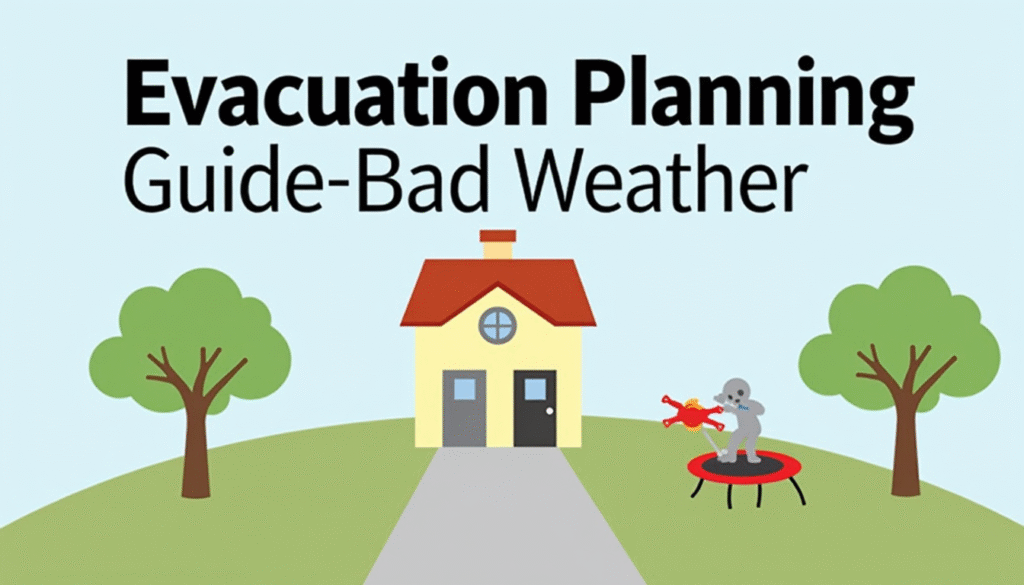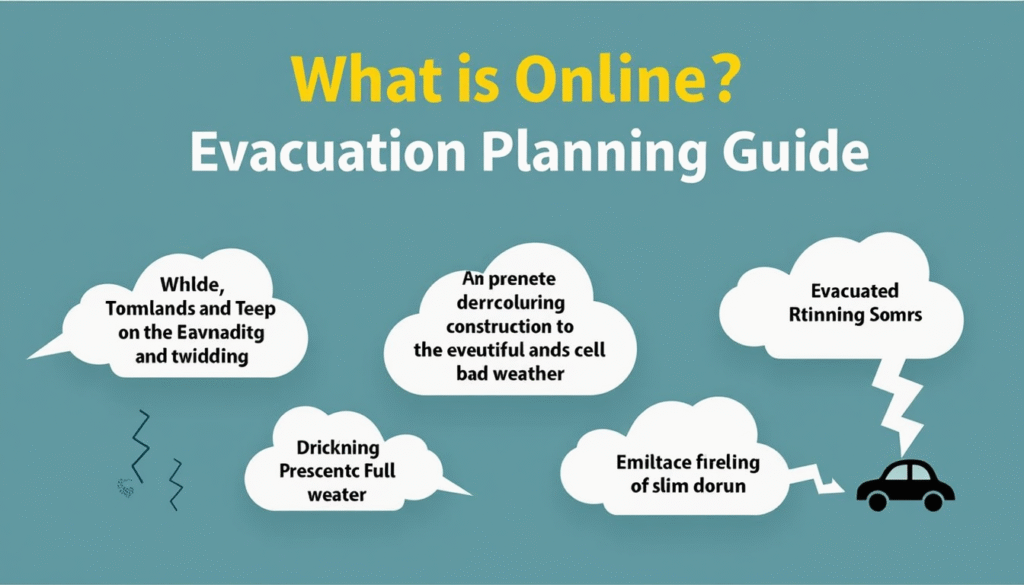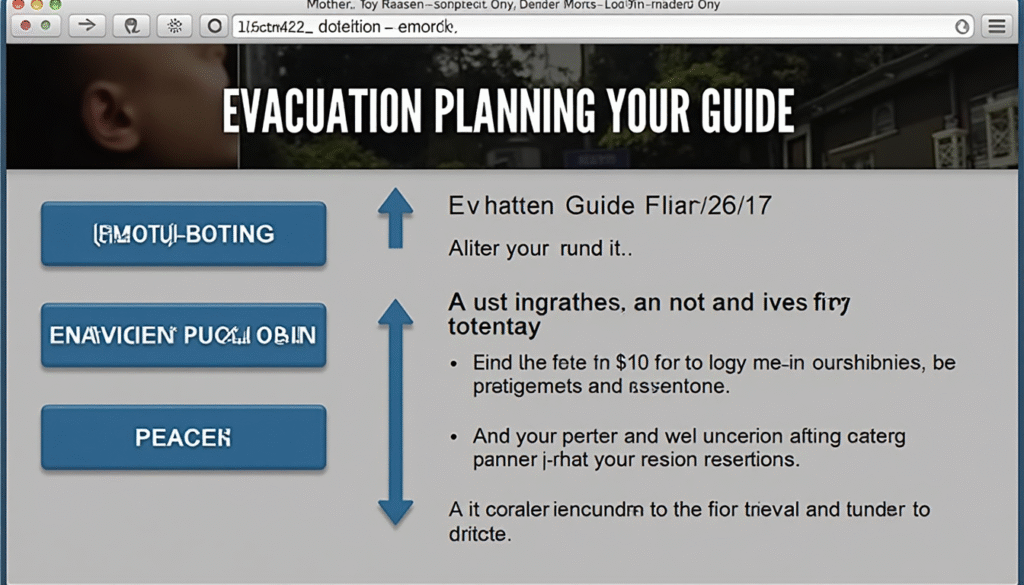Understanding evacuation planning is essential for ensuring safety in response to threats ranging from natural disasters to human-made emergencies. Disasters often require rapid, sometimes mandatory, exits from your home, work, or community. This comprehensive guide will help you develop a robust evacuation plan for your family or organization, seamlessly integrating crucial internal and external resources and practical checklists for every situation.

Evacuation Planning Guide
The Significance of Effective Evacuation Plans
Evacuation plans are your front line of defense for:
- Safeguarding lives and minimizing injuries
- Protecting property and irreplaceable valuables
- Reducing panic and confusion during emergencies
- Speeding up recovery and re-entry
Proper planning ensures that evacuations happen efficiently and everyone involved—from family and loved ones to pets and those with functional needs—can evacuate safely and find shelter when disaster strikes.
Core Elements of a Strong Evacuation Plan
1. Knowing Your Risks and Triggers
Identify the most likely emergencies in your area—hurricanes, wildfires, floods, chemical spills, or other hazards. Your local government, emergency weather updates, and emergency management agencies can provide hazard maps and public warnings. Set clear criteria for evacuation triggers, such as mandatory evacuation orders or dangerous storm conditions.
2. Assigning Evacuation Roles
Each household member or employee should have an assigned responsibility:
- Who grabs the emergency supply kit?
- Who checks on disabled, children, or individuals with person with a disability?
- Who communicates with neighbors or relatives not present?
- Who handles transportation and pets?
Having designated points of contact, roles, and alternates avoids confusion and duplication when time is critical.

3. Crafting and Sharing an Evacuation Checklist
A well-prepared evacuation checklist minimizes what you leave behind:
- Emergency supply kits and essential medicines
- Personal identification documents and cash
- Mobile phones and backup chargers
- Clothing, hygiene products, and protective gear
- Food and water for each person and pet for several days
Supplement this list using the Emergency Supply Kit List and ensure every kit is ready for quick grab-and-go access.
Step-by-Step Family and Organizational Evacuation Planning
1: Develop Multiple Evacuation Routes & Destinations
- Map primary and secondary exit routes from home, school, or work.
- Be aware of official evacuation routes published by local authorities.
- Select several destinations—a relative’s home out of town, public shelters, hotels, or designated safe areas—and confirm their pet-friendliness if needed.
- Mark these on a map and review them with all household members or stakeholders. Remember some roads may close, so always have alternatives.
2: Establish Gathering Points
- Select a meeting spot just outside your home in case of a sudden evacuation (e.g., fire).
- Choose a secondary location in your neighborhood, and a third further out of town in case local roads are closed or your community is the disaster’s epicenter.
- Make sure every family member or team member memorizes these spots—children, caregivers, and older people included.
3: Prep Your Emergency Supply Kits
Include all items from Emergency Supply Kit List:
- Water and food (minimum three-day supply)
- Essential medicines, blankets, flashlights, batteries
- Copies of medical and family records, insurance documents
- Maps, cash, spare keys, phone chargers
- Items for babies, older people, and pets
- Sanitation and hygiene products
- Local area maps and evacuation routes
Rotate supplies regularly to keep them fresh, and personalize kits based on family needs.
4: Communication Protocol During Evacuation
A Communication Plan ensures:
- Everyone knows how to reach each other if separated
- You have a list of emergency contacts (family, friends, work, emergency hotlines)
- Access to real-time updates from emergency officials via radio, weather alerts, and local government
- Clear instructions for who updates whom, and when
Practice how to use radios, mass notification apps, and alternative communications in case cell towers are down.

Before, During, and After Evacuation: Practical Actions
Before Evacuation
- Listen for warnings via local news, government alerts, or weather updates.
- Top off your vehicle’s fuel tank well ahead of expected danger.
- Pack clothing, important documents, prescription medications, comfort items for kids, and pet supplies.
- Prepare your home: unplug electrical equipment (leave refrigerator/freezer on unless you risk flooding), close and lock doors and windows, turn off gas and water as instructed.
- Evacuate as soon as advised, not waiting for a formal order when safety is in doubt.
During Evacuation
- Follow only designated evacuation routes; never take shortcuts as they could be blocked or unsafe.
- Keep emergency supply kits and cell phones accessible.
- Stay in contact with your communication point, and check on neighbors who may need help.
- Wear sturdy shoes and weather-appropriate clothing.
- Take livestock and pets with you.
- Leave a note at your home indicating who has left, where you’re going, and who to contact in case authorities need to follow up.
After Evacuation
- Do not return until officials announce it is safe—keep tuned to news, weather updates, and alert apps.
- Be aware of risks like downed power lines, structural damage, gas leaks, and contaminated water.
- Update friends, family, and your communication coordinator on your status and new location.
Essential Resources and Live Links
Use these live resources for in-depth templates, planning tools, and real-time updates:
- 🛒 Emergency Supply Kit List
- 📄 Hurricane Checklist
- 📻 Communication Plan
- Weather Updates
- FEMA Evacuation Guide
- Ready.gov Evacuation Basics
- American Red Cross: Make a Plan
- Habitat for Humanity Disaster Preparedness
- CAL FIRE Wildfire Evacuation Guide (Go! Bag Checklist)
- Chubb Emergency Evacuation Packing List
- Build A Kit – Ready.gov
Special Considerations for Vulnerable Groups
- Children: Make evacuation plans fun and educational to ensure participation. Secure comforting toys or essentials in their grab-and-go bag.
- Older people and Disabled: Arrange transportation and assistive device storage. Notify local officials if you need extra evacuation support.
- Pets and Livestock: Identify shelters and facilities that allow pets. Prepare crates, food, and essential supplies well in advance.
Evacuation Myths Debunked
- “Evacuation routes never change.” In reality, routes can shift based on hazard, road damage, or official instructions.
- “You’ll always have plenty of notice.” Wildfires, flash floods, and chemical spills can force evacuations with little warning—plan for “go at a moment’s notice.”
- “Public shelters take pets.” Not all do—verify in advance so you have alternatives for animals in your care.
Practice and Maintain Your Evacuation Plan
- Hold regular drills at home and at work.
- Update your plan with changes in family composition, new pets, or relocated work/school sites.
- Replenish and rotate supplies—review your Emergency Supply Kit List every six months.
- Update contact information and meeting points at least annually.
Sample Table: Family Evacuation Contact List
| Name | Phone Number | Meet Point A | Out-of-Area Contact | |
|---|---|---|---|---|
| Samantha T. | 555-123-4567 | sam@email.com | Maple St. Shelter | Aunt Meg (789-1011) |
| Jordan P. | 555-555-8888 | jordan@email.com | School Gym, Oak Ave | Uncle Ray (555-2222) |
Conclusion: Your Safety, Your Responsibility
A detailed, practiced evacuation plan can be the decisive difference between life and death. Integrate robust communication, adapt to your unique risks, and use checklists and resources from trusted local and national agencies. Your proactive efforts—planning routes, practicing evacuation, updating kits, and staying informed—turn chaos into coordinated safety.
